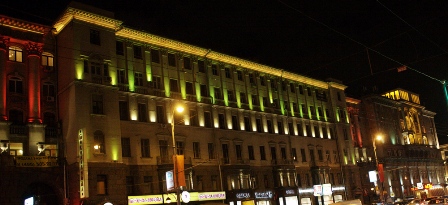Categories: Featured Articles » About electricians and not only
Number of views: 17984
Comments on the article: 6
Design profession
 Any construction begins with the project. Suppose we have two brick cars, a cement car, a car of various pipes, and a floor of a car of electric cables. What, first of all, do we need to do to build a house, a production hall or a stadium from all this diverse material?
Any construction begins with the project. Suppose we have two brick cars, a cement car, a car of various pipes, and a floor of a car of electric cables. What, first of all, do we need to do to build a house, a production hall or a stadium from all this diverse material?
During the construction, hundreds of people of various specialties simultaneously perform their work, and as a result of their joint work, a beautiful and convenient building is erected. In order to make this possible, before the construction of any building or structure occurs sacrament of design.
Long before the start of construction, they come to the place of future construction architects and designers. Architects are primarily responsible for the beauty of the future building. They are needed, first of all, where special requirements are imposed on the facades of buildings and their interior decoration. They create architectural drawings that show the appearance of the building, walls decorated with various columns and cornices dividing the building into several horizontal levels.
Using various architectural techniques, they either push the building up, decorating it with columns and pilasters, or give the building a monumentality with the help of various cornices. Cornices are often decorated with decorative moldings. Their project, as a rule, does not contain detailed detailing of all foundations, walls and ceilings. Architects also create interior interiors.
There are narrowly focused architectural directions, for example, artistic lighting of buildings. Here, an architect - a lighting engineer must feel how the light of a particular lamp "lies" on the columns, cornices and window panes.
For architects, an artistic perception of reality is very important. But, if almost any person is able to distinguish and evaluate beauty, then not everyone is able to create this beauty. In the training of architects, much attention is paid to drawing. In general, to get any specialty related to the implementation of something beautiful, students are taught primarily drawing.
 After the architects have completed their part of the work, the designers begin work on the project. They will perform calculations of foundations, walls and floors. And they will create detailed drawings of the building under construction, according to which the builders will erect it.
After the architects have completed their part of the work, the designers begin work on the project. They will perform calculations of foundations, walls and floors. And they will create detailed drawings of the building under construction, according to which the builders will erect it.
The designer's work is as creative as that of architects. But the beauty they create is often hidden from our eyes: the powerful foundations of tall buildings can go dozens of meters into the ground, admiring the power and beauty of specialists. But truly the main connoisseurs of the beauty created by building designers are the designers of engineering systems.
Engineering Systems Designers are the largest army of designers. They develop detailed drawings of various building systems. These are water supply and sewerage, electricity, ventilation and air conditioning, fire alarms, low-voltage networks (telephone, television), computer networks.
In a well-designed building, engineering networks are laid in specially designated areas: vertical niches for the entire height of the building, various tunnels and technical floors. In a well-designed building, it is possible to lay all communications so that after installation they will be available for maintenance and repair.
 Engineering systems design - a complex procedure that requires concerted action by a large number of designers in different directions.
Engineering systems design - a complex procedure that requires concerted action by a large number of designers in different directions.
For example, in an ordinary office building, most engineering systems are carried out in a space behind suspended ceilings.This space is limited by the height of the ceilings. And to fit in this limited space and ducts of supply and exhaust ventilation, trays with electric cables, pipes and much more - this is not an easy task. Moreover, this is possible only with the close cooperation of all project participants.
Now computerization of the design process is helping to solve these problems. But computer cannot replace human knowledge. In the first place is always the literacy of the designer. If the designer is not able to carry out projects without a computer, then no computer with cutting-edge software can help him.
Consider the design process and the interaction of designers of various directions on a rather specific example: the creation of architectural - artistic lighting of the building. Here the lighting technicians (architects of lighting systems) chose the types of lamps for lighting the facade of the building, and determined their installation location. Next, the designers of the power supply for lighting installations begin work - they will determine the power of the entire system, choose electric cables and how to lay them, calculate the required cable cross-sections, loss in lines and develop electrical panels. At the same time, designers work with them - they develop all kinds of brackets and structures for fixing fixtures.
Drawings of brackets and structures are sent to the technologists at the plant. Technologists will determine on what equipment all the fixture attachment points can be manufactured, write technological maps and transfer them to production for manufacturing.
Near each house a person cannot be set to control the illumination of facades. Therefore, designers of automated systems are connected to the work. They create automated lighting control systems for the building. That allows you to quickly control the lighting and track the occurring malfunctions in the system.
Modern luminaires for illuminating buildings mainly use LEDs as light sources, which provide low power consumption and have ample opportunity to create luminaires with a changing color of radiation. Such lamps can create radiation of any color. With their help, you can even work out various lighting scenarios and dynamic effects. Each lamp in such a system is connected not only to the electrical panel, but also to a special control device that supplies signals to the lamp and controls the color of its radiation.
In order for this lighting system to turn into a true work of art, specialists in lighting scenarios are involved in the work, who, like composers, create various works based on lighting solutions.
But this is not enough, therefore, further programmers are involved in the work, who must write programs for each type of lamp so that they “obey” their conductor.
At first glance, such a complex chain runs through a simple matter - to illuminate the facade of a building, for example as shown in the figure. Here you can see the illumination of the cornice of the building, columns and window panes. It is important not only to beautifully illuminate the facade, but also not to create inconvenience to residents of buildings, for which they are used, for example, spotlights with a very narrow light beam of scattering.
The profession of any designer combines the elements of creativity and the knowledge of a large volume of various specific design rules.
Victor Ch
See also: Profession - Electrician for crane service
Programs for designers: Programs for stripping electrical circuits
See also at bgv.electricianexp.com
:

